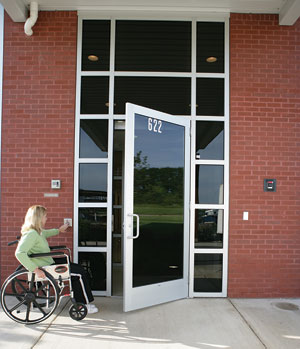First in Their Class: Innovative Design Solutions for Schools of the Future
Accessible Entries that Control HVAC Cost
 |
Providing wheelchair accessibility through a swing door requires knowing act activation. Photo courtesy of Horton Automatics |
According to Ron Grabowski, marketing product manager of Horton Automatics, "Increased focus on handicap accessibility, energy savings and student safety has driven the adoption of automatic means for entrance operations in school facilities."
Particularly on college campuses, demand for student safety and accessibility is a 24/7 requirement. Budget cuts that have reduced maintenance and security staff have created opportunities for new design solutions. Electronic access control systems such as card readers have become popular additions to new door installations.
Automatic swinging, sliding, and revolving doors must meet the American Disabilities Act (ADA) and the American National Standards Institute (ANSI) requirements to provide safe access to building occupants. Automatic doors are typically part of a vestibule design to reduce heat transfer to and from the building. Swing and slide door systems are routinely synchronized so that one will open after the other one has closed. Often architects and designers combine swinging, sliding and/or revolving doors in an entrance to enhance aesthetics and optimize energy efficiency. In this arrangement, the second set of swinging or sliding doors will not open until the first set has closed, completing the air lock in both cold and hot climates.
Case Study: Energy-Saving Automatic Revolving Doors |
Automatic and manual revolving doors have increased environmental benefits. In 2006, Massachusetts Institute of Technology (MIT) students studied the value of energy loss using swinging doors versus revolving doors.11 These students, members of a sustainability planning class, were curious about the use or lack of use of revolving doors on campus. The students wanted to know why users were less likely to use a revolving door and more often opted for the adjacent low energy or standard swing door. A revolving door reduces air leakage because its curved design provides an air lock, effectively acting as a small vestibule. Due to this curved design, revolving doors are excellent entrance and exit systems for controlling heat transfer between the interior and exterior of a facility. Swing doors are used next to revolving doors because swing doors are required within 10 feet of a revolving door as required by the National Fire Protection Association 101 Life Safety Code. The MIT students measured the air leakage between the use of revolving and swinging doors. They calculated that to heat and cool the annual air leakage through a typical entrance (both swinging and revolving combined) was 98,912.8 kilowatt-hours (kWhs) of energy. That energy is enough to heat 6.5 single-family houses for one year, or to light a 100 Watt bulb for 37.8 years. To generate that much energy, 18.8 tons of CO2 is emitted. They calculated that by increasing the use of revolving doors from 50 to 100 percent, MIT could save from 14.5 percent to 74.5 percent of the energy costs from a given door leaks and from 3 to 14.6 tons of CO2. During the research, the majority of users responded that swing doors were easier and faster to use and the manual revolving doors were harder to push and often locked. However, when told that there could be as much as a 50 percent energy savings increase for MIT by using the manual revolving doors, more students said that they would use the revolving door if signs were added with this information. The final results of this study included recommending additional educational signage at the swinging doors and the automation of the revolving doors. In 2009, students began a "Resolve to Revolve" campaign as part of a sustainability MIT initiative. |
An important facet of using Low-energy/ADA-compliant swing door operators for entrances and vestibules is ensuring that architects and specification writers apply them to the appropriate MasterFormatâ„¢ sections. At times, these types of swing doors are specified in sections 08 06 71 or 08 71 00 "Door Hardware Schedule/Door Hardware" rather than the correct sections of 08 42 29.33 or 08 71 13 "Swinging Automatic Entrances/Automatic Door Operators." Why is this critical? Doors specified in the appropriate sections ensure that:
- An independent, certified professional installer trained through the American Association of Automatic Door Manufacturers (AAADM) completes the installation
- ANSI standards for opening and closing of doors are followed, reducing risk and liability
- Automatic operators are properly calibrated and meet applicable codes for mode of operation
- Operators are paired correctly with the doors and associated hardware
- Product and labor warranties are backed by qualified professionals









